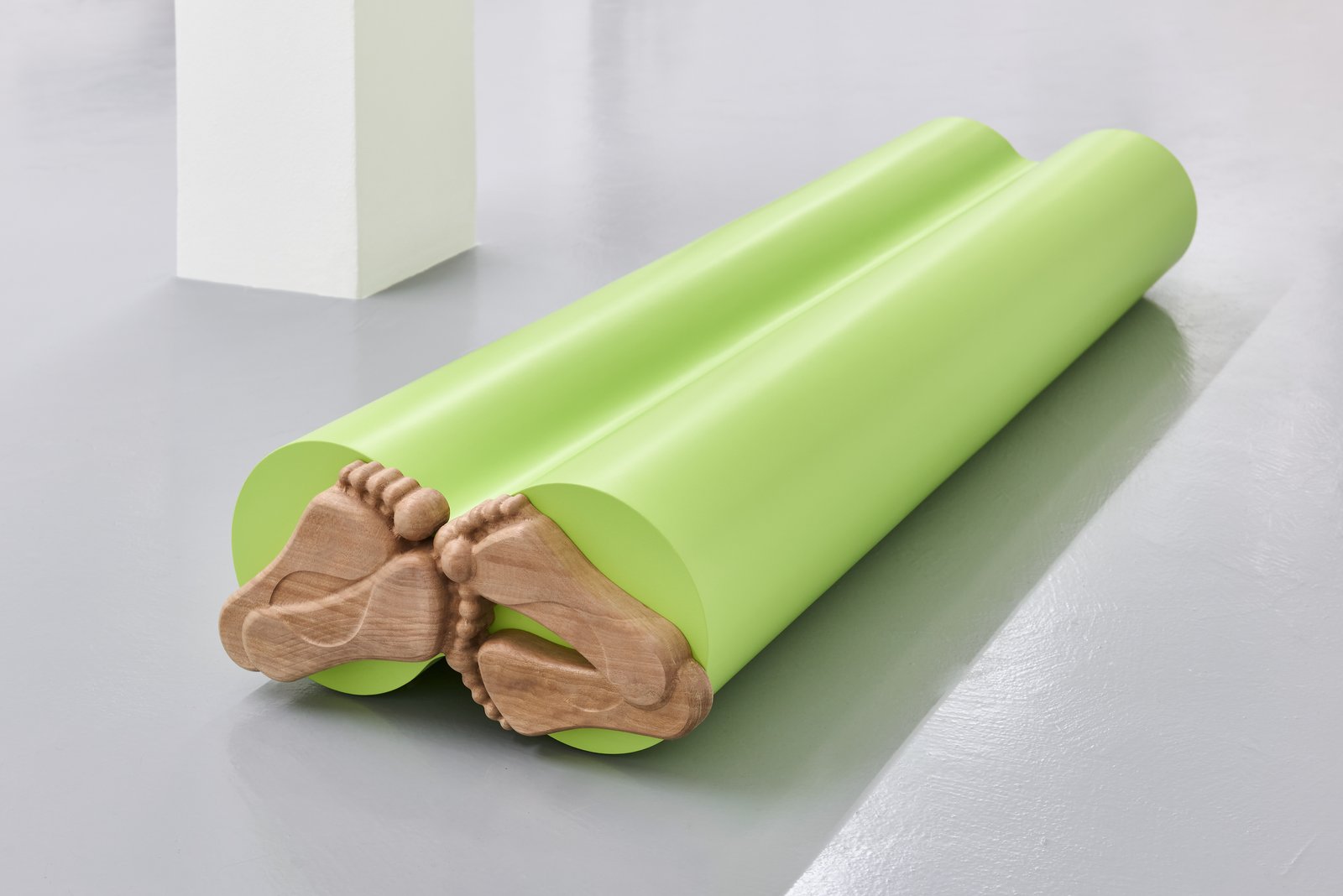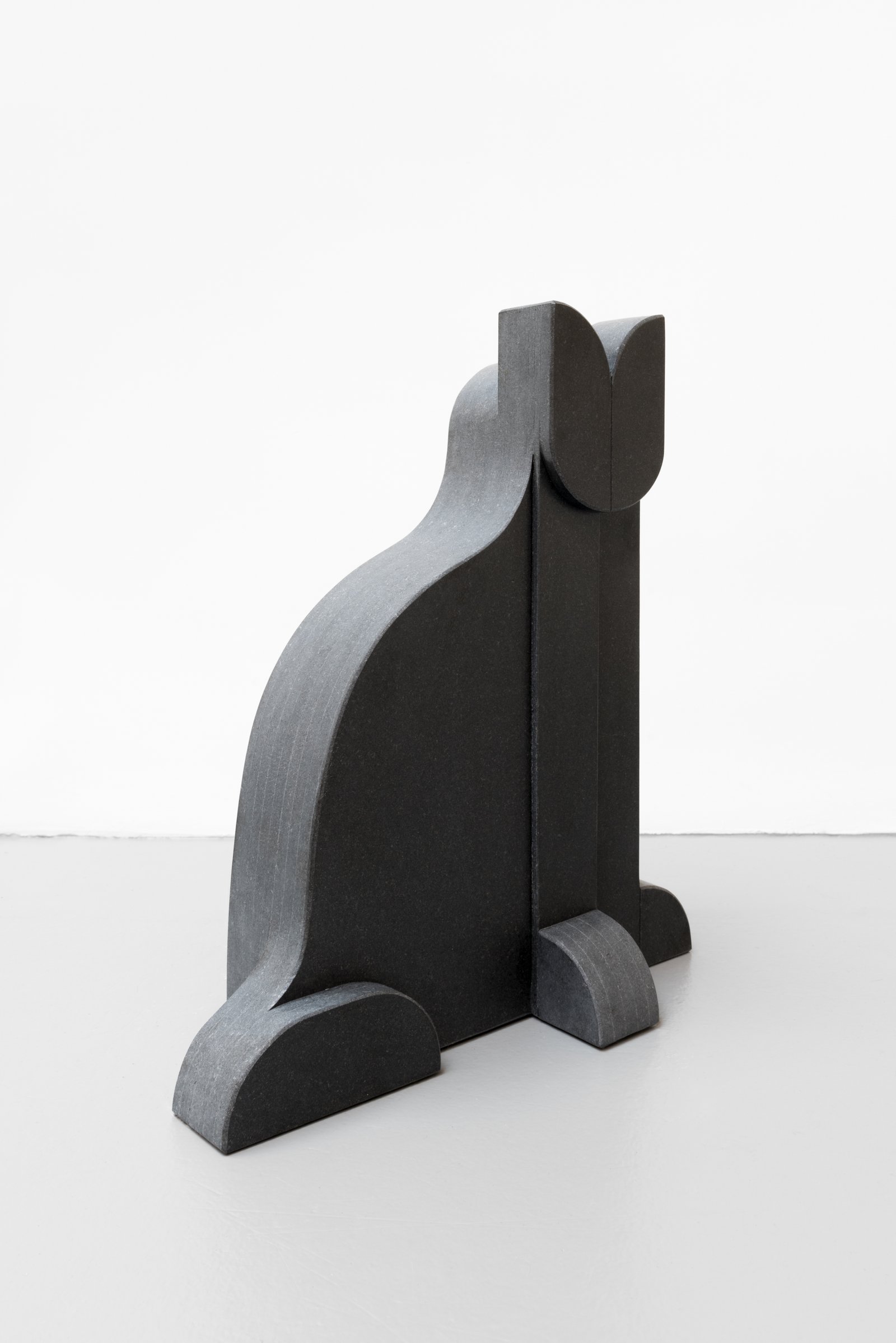Federico Cantale, sculptural axonometries
Federico Cantale works with friendly forms, the result of a rigorous vision that sees in all things their deepest norm.
“The work was born from an intuition about the symmetry created when people blow up a balloon with their mouths”. These are the words that Federico Cantale, born in 1996, chooses to introduce Tra me e me (2024) and Tra sé e sé (2024), a pair of works presented last spring at Triangolo in Cremona, from which I would like to approach his practice and thought.

“Tra me e me (2024) and Tra sé e sé (2024) – writes Cantale in an e-mail communication – are two titles for a single work”. Two variations on a single sculpture, marked by homophonic titles and profoundly similar content. More precisely, for an idea of sculpture. Each of the works has a composite volume consisting of a first spherical element from which a second, also spheroidal, slightly downward sloping body emerges. Far from the ground and from pedestals, the works are installed at a height of about one and a half metres. The vertical defines their axis, and it is in the air that these sculptures exist, floating in a tiny, endless effort. There is then another element to be posited. The duality of form that suggests the double title, and not vice versa, is spontaneously reflected in a further conceptual pair: that of matter and material. This is not an oppositional logic, but a very ancient tension that runs through the histories of sculpture, intercepting a metamorphosis, or perhaps it would be more appropriate to discuss of a transformation, that focuses on sculpture and its image, its existence as presence and projection at the same time. Matter and materials, then. The first of the spherical bodies constitutes a delicate piece, a terracotta shell made of white clay in the first version and of an ovenproof clay in the second, both made by negative moulding and fired. The second volume is a balloon, a rounded latex bubble: again, white and orange.

The design of the works represents a dense junction for Cantale. It is, above all, an expression of thought in motion: like a sparkle, the sculpture shimmers in the imagination, and its idea is modelled by the artist with daily care. Drawing plays a crucial role in this phase. Both as a means of attempting a morphology of praxis – when meditating on new sculptures, Cantale often sketches a landscape of his previous works – and as a means of verifying a formal composition, the execution of which, generally through assemblage, could be carried out by the artist himself or in close dialogue with craftsmen. And one of the focal points of Cantale’s thought is precisely the search for formal composition. That is to say, for that peculiar configuration that allows forms to be a mass of elements, colours, correlations, at the same time, bearers of a gesture that originates from this one and only configuration. Ultimately, Tra me e me (2024) and Tra sé e sé (2024) interrogate the potentially infinite possibility of an encounter between two ovoid forms. A combination that evokes several images, including that of the slightly recumbent head, a theme par excellence in sculpture, especially in the late 19th and early 20th centuries, and that of the breath, now more properly pictorial.

For Cantale, therefore, form seems to constitute the starting and ending point of sculpture, where the image, or rather the gesture, defines the voice, the story, the idea of that sculpture. Such a tension, which can be seen in the artist’s early works, could be defined in terms of processuality. A concept, however, that does not refer here to the extraordinarily literal correspondent of certain contemporary experiences of Arte Povera and North America, but again focuses on the peculiar tension that is determined in narratological terms between the matter and the image.

Consider the two versions of Trance di Miele (2021, 2024), exhibited by Triangolo (Cremona) and Ordet (Milan) respectively. Consisting of two wooden cylinders of anthropomorphic proportions, painted red and green and placed horizontally on the ground, it is a sculpture of the earth, not the air.

The whisper of these sleeping sculptures, their breath, is materialised by a pair of wooden feet that close one of their extremities: the minimalist afflatus of the work is dispelled by the gesture that the sculpture actively interprets. Even in a work as playful as Felina (2021), a sculptural axonometry of a black cat, this processuality seems to emerge in the semantic gap between the image of the cat and its conceptual and modular translation.

From these few, very few works borrowed from Cantale’s corpus, it is possible to guess the reservoir of artistic references, present and past, that the artist has intercepted in various ways. A set of sources which, on the one hand, sees the aegis of Fabro and Fontana as a ceramist, but which also preserves the legacy of that fortunate period in which the making of sculpture depended on an extraordinary vis compositiva, from Consagra to Marotta. On the other hand, this formal rigour is accompanied by a playful dimension not unfamiliar to many contemporaries in the sculptural field, including Camille Henrot, Camille Blatrix and Rodrigo Hernandez [here is our writing about Hernandez, Ed.].
In this regard, Tra me e me (2024) and Tra sé e sé (2024) seem to describe the slight variation in the order of the puff, which makes the airs vibrate, but not the principles defining the artist’s world. A world of friendly forms, the result of a rigorous vision that sees in all things their deepest norm.
November 8, 2024
